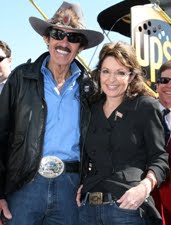 Time for Sarah to Grapple:
Time for Sarah to Grapple:Sarah Palin’s current book tour has afforded her overwhelming media exposure, including numerous high-profile television interviews. The full array of her strengths and weaknesses were on display, and she would be well advised to examine both in depth.
Palin has many allies and supporters. She has won their hearts by, in most cases, showing she is like them. She is, however, still despised (read, alternatively, feared) by her opponents, particularly the coastal “elites” who simply refuse to see her as intellectually competent to handle high office.
While her book and media blitz give plenty of evidence to the contrary, this resistance can be confronted in part with a few minor but consequential tweaks of her style. These adjustments can all be learned and must be practiced. If absorbed into a natural manner, they will make a major difference in how her opponents are able to object to her. Whether or not she ever runs for office, her impact upon both fans and foes is too formidable for her to leave this matter unattended.
Simply put: Palin must learn how to convey to her audience that she comprehends and can grapple with the depth and nature of presidential-level problems. This is the fundamental weakness to which most other criticisms of her are tethered.
In an attempt to demonstrate her proficiency, she often rushes to show she has an answer to issues — on health care reform, Afghanistan, the economy, energy security, Iran, and so forth. She also likes to show that she can somewhat succinctly summarize a solution or strategy and then pretends to be comfortable with her simplicity.
This is, however, fodder for her opponents, who like to think of themselves as intellectually superior not only to Palin but to the rest of us as well. They argue, not without reason, that Palin simply does not understand the complexity of our problems. Consequently, to them she appears little different from high school or college students foolishly believing they are experts on a subject to which they have just been exposed.
In contrast, (and while arguably much less “qualified” for executive office than Palin) President Barack Obama has mastered this game. Palin should study Obama’s effective style and utilize some of his most rudimentary techniques.
Obama will frequently appear to answer a question by articulating something worthy from each side of the debate. He will use the disjunctive form, saying “on the one hand …” and then pointing out “however, we must be mindful of. …” This is precisely the skill of the law student and lecturer that he was. Law school training is steeped in “issue spotting” or expressing the understanding of each side’s arguments. Obama is a Jedi at this talent.
It should be made clear, however, that Obama simply uses this as one of his many sleight of mouth tools. He frequently talks of bipartisanship and “bringing folks together” and creates the sense that his recognition of both sides will engender an open and deliberate struggle to get to the truth. In fact, Obama actually does none of this and resolves issues with the typical far-left bias he brought to the table. And often, he seats no one from the other side at the table at all.
And Obama’s grappling yields little in return. He spent months grappling with the intricacies of Afghanistan and Pakistan only to generate an incoherent policy which is even disliked by the very leftist elites who idolize the Grappler. Obama has spent his entire term to date grappling with “jobs” only to have greatly increased unemployment. And his solution? More grappling with the “Jobs Summit.”
This works on Obama lovers because they tend to hear him demonstrate that he “gets” both sides; they then presume and impute that he is likely to come out with the best answer. They simply defer judgment to him after being comforted that he will “grapple with the difficult realities” on their behalf. Palin needs to steal this very simple but effective move.
How does Palin begin to convey “grappling”? First, she must articulate a worthwhile interest from the other side. It only need be a consideration, not a winning argument. Once she convinces her audience that she sees both sides, they will take it from there and begin to transfer trust that she is equipped to formulate the best resolution.
A few other Obama moves can also help. First, pause before talking. Palin has a tendency to rush to show she has the answer. Yet to some, this can have the unintended consequence of feeling like an exam “crammer” who wants to get it out before she forgets her crib sheet. Take a breath. Your “elite” and self-identified “sophisticated” listeners appreciate the “thoughtfulness” that a pause can suggest.
Similarly, talk more slowly. Palin has a tempo that can aggravate certain listeners. It seems to come from genuine enthusiasm but can be offsetting to the “intellectual” crowd that likes to savor the wisdom it thinks it obtains from the likes of an Obama.
More importantly, learn when to stop talking. Great musicians learn the value of the “rest.” Great speakers know when to lay back. Palin sampled this from time to time in certain television interviews last week and the effect was dramatic. A little practice and she’ll have it down.
One tactic she does employ is to utilize the interviewer’s first name. Used car salesmen do this frequently, as does Obama.
However, Palin typically rushes through her response such that the name fails to properly subdue the interviewer and, by extension, the viewer. The technique gives the suggestion of confidence and interpersonal openness but is most effective when the subject pauses, perhaps even leans into the interviewer (or even touches him), and changes into a serious tone for the answer: “Well, Charlie, this is a difficult maze to work our way through.”
She should also develop greater facial expression flexibility. Obama has learned to purse his lips and frown at key times to appear to be the consummate grappler. Tilt your head occasionally with a grimace. Looking down with a pause can help at times. Show little moments of unease with the simple fact that reality is not as neat as we would like it. Palin can even express that very thought: “I wish the world offered easy answers, Barbara” and “Oprah, we have tricky and thorny choices in front of us” and so forth. (Then, proceed to hit a simple statement out of the park!)
Palin connects her conservative principles well with her answers to specific problems. However, she sometimes does so with a rambling that detracts from the import of those principles. She might do well to limit herself to one principle per answer so that the audience has more time to savor each one.
All of these maneuvers are simple and require only small adjustments. It may seem counter to her image of being “natural” to employ them. To the contrary, they could truly assist her in better conveying what is, ironically, most natural to her: outstanding instincts for leadership.
Start grappling a little, Sarah.



















No comments:
Post a Comment